When I left teaching college in the early Nineties, laminated sheets were not used. If we really needed something covered we had to use stickyback plastic. It was expensive and you learned to develop the knack of avoiding lines and bubbles appearing. In my outdoor and teaching jobs in the Eighties and Nineties, we mainly used poly pockets to stop paper getting too wet.
Over the years, the use of the laminating machine has become commonplace. In fact, I’m sure many educators can’t remember a life before a laminate.
In recent years I’ve stopped laminating paper altogether. I’m aware that it creates a considerable amount of landfill as the paper can no longer be reused or recycled. When the plastic does eventually start to break down, it’s into smaller pieces – often at a micro level that remain hazardous to our own and other species’ health.
Also, outside, the weathering processes do result in exposed laminated sheets looking rapidly worn or “daggy” unless sited in a shelter away from the elements. Here’s an example of a wildlife hide in a local nursery that’s done this:
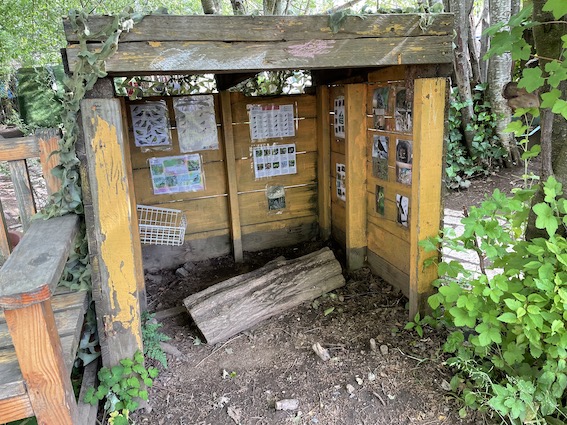
Ultimately we need to think about why we need a sign, label, worksheet or other form of written communication and if it can be avoided altogether. Are we better going for ephemeral approaches such as writing in the sand which is temporary?
I still have some laminates and other plastic resources that I’ve had for many years for training purposes – just in case you go on one of my outdoor courses and encounter some. I would rather wear out a resource than chuck it in the bin to give the appearance of being right on. Also I think it’s important to demonstrate that my own thoughts, attitudes and actions shift and change too. You will also see that I have lots of alternatives which I use as well. Some are more environmentally friendly than others, bearing in mind that unless you are very diligent about your use of renewable energy and avoid the use of permanent marker pens, everything has some impact on the environment. It’s different shades of grey rather than black or white choices.
So how can this be achieved when working outside? With a little thought, it’s surprisingly easy. For early years educators, there is a lot of overlap with mark making possibilities outside too. I hope the list also is encouraging if you are already using many of these ideas.
1.Avoid creating displays which require laminated sheets.
In my experience, going laminate-free leads to many more creative approaches particularly regarding signage. Also, the making of the signage or display becomes part of the experience of working with a class or group of children outside. Look at making simple wooden signs, which is a good technology project for children. These can be re-used if painted over. You can buy eco-friendly gloss paint, suitable for use on wood outside.

At Bennachie Woods recently, the information was varnished onto wooden slates. I’ve no idea if the varnish was eco friendly – but it is possible to buy this from a range of suppliers. The approach definitely creates a more aesthetically pleasing design.
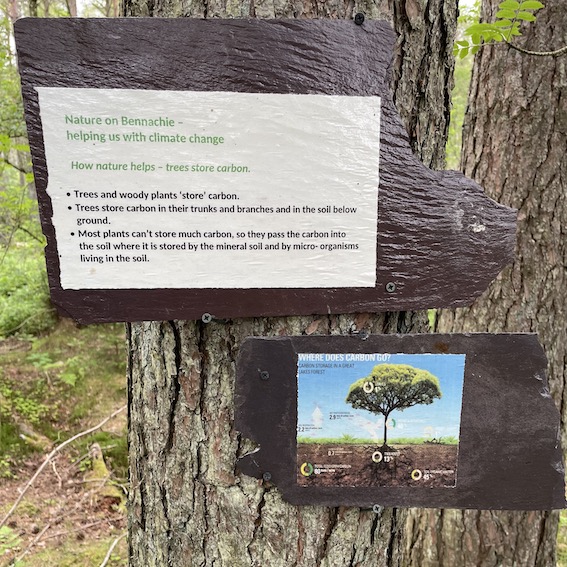
2. Wooden alternatives
Large or small, wood is can be very useful. Do check you are using products that are sustainably sourced with FSC certification.
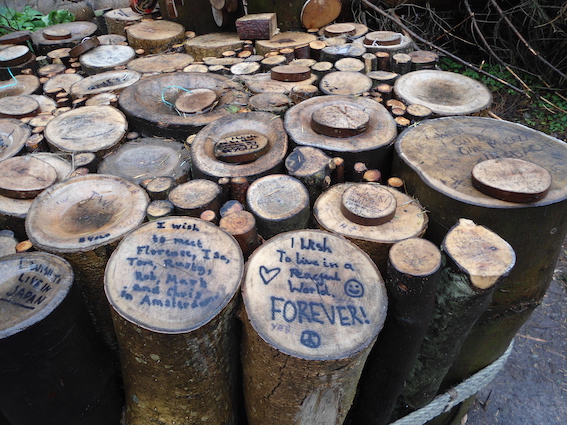
Wood burning etching tools can be used with older children and adults who can create wonderful resources from little wood cookies to signs and even bunting – as illustrated in the photo below! Wooden lolly sticks are great for brief comments, words, thoughts and so on.
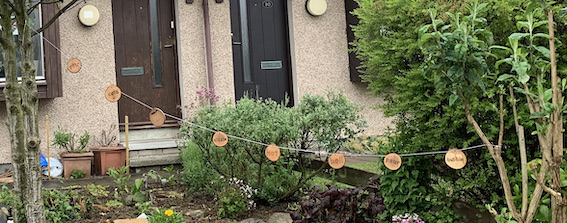
It’s also possible to purchase a range of varnished wooden products from Cosy which can be used for writing – but I’m not sure how eco friendly the varnish is.

3. Free and found materials to make signs
This is another creative approach which often intrigues children as the objects used are good for discussions. Ali Wiseman, a teacher at Drummond School in Highland, has let me know that plain lino offcuts works very well. Linoleum is a water-resistant flooring material that’s often made of plastic. According to Ali:
It’s free (offcuts from flooring companies who are only too glad to get rid of it), I cut it to make shapes, frames, and write on lino ‘pebbles’ for letters and numbers instead of stones or wood. It’s light, so much safer for us, durable and it doesn’t really matter if it gets lost. I’ve been using it for about a year and no issues… At first I worried about chemicals from it but this doesn’t seem to be a problem.
It’s also possible to source genuine, old-fashioned linoleum that is much more environmentally friendly made from linseed oil, wood flour and cork dust.
4. Stones and rocks of different sizes.
This includes old roofing slates or other flat rocks. Small ones enable children to move words, symbols and pictures around and have greater engagement. Acrylic deco marker pens are great in that they are waterproof but they do gradually wear and may result in tiny amounts of plastic going into the environment.

5. Old sheets and scraps of plain material
Many educators now know about the joy of hapa zome or the flexibility of cotton tens frames and other mathematical markings. They also work well for lists, key words and prompts and so on. Once cotton has been used in this way, it can be further re-used by recycling into char cloth which is a useful fire starting resource.
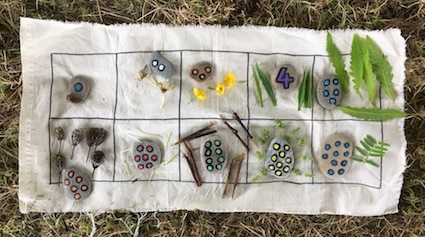
Whilst I tend to have stuck to cotton, one Facebook friend, Kathryn Grogan flagged up the use of sail cloth and spinnaker fabric off-cuts for using outside with pens to make hand-written signs.
6. Cardboard and boxboard
This can look lovely without being covered in plastic. If the sign is in a sheltered spot it may last a surprisingly long time. Unlike paper, cardboard is less likely to go completely soggy. Use permanent marker pens if you live in a damp climate. One challenge is that most marker pens tend to be thrown away once they have run dry. It is possible to buy ones that are made from more recycled materials and are refillable such as this product.
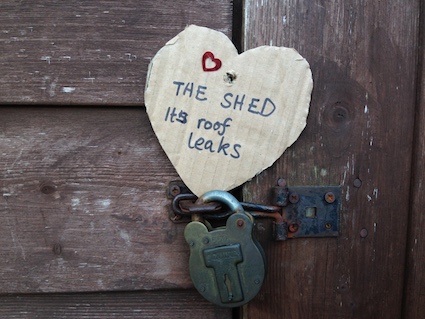
Mandy Tulloch, a good friend who runs Mud Pies, also has the following recommendation for mounting card:
“One of my most favourite alternatives to laminating is mounting card. It’s made an amazing difference to my work outdoors. A while ago I discovered picture framing businesses throw out the rectangles of card that result from framing paintings. They usually have loads of it lying around waiting to go to recycling which seems such a waste. I now have a relationship with my local framers who keep a bag for me. In return I leave a donation with their favourite charity as none of them would take any money for it.The card is fab to work with. It’s rigid for writing and drawing on, can act as a kind of clipboard or small table and is thick enough to make into signs. In the dry it would last for ages but you could put it in a polypocket too for extra longevity. Only thing you need to watch for is that the edges can be sharp so you can get paper cuts. Rubbing a pencil along them helps though. Then, when all finished, you obviously recycle it. Really works for me!“
7. Blackboards
If you need to make announcements or change wording on signs a lot, then this can be good. Look at how cafes use blackboards for good ideas about style and presentation of text.
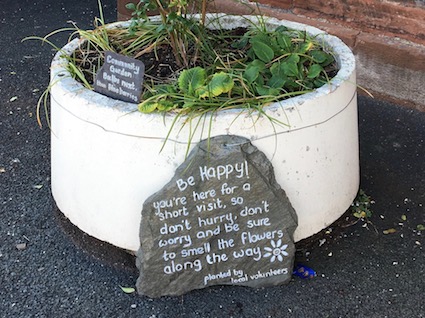
Google chalkboard paint for eco friendly paint to use for this purpose. Remember too, that chalk can work applied directly to old slates without the need for chalkboard paint.

8. Metal tags
Gardeners have used copper and aluminium on an ongoing basis to label plants. These outlast plastic tags considerably. Some can even be used with a pen or pencil rather than needing a stamping letters – which did make me reminisce about my metalworking lessons in my own school days.

Re-using plastic items
As a halfway measure I’m using re-usuable plastic in different ways. Whilst this is far from ideal, it’s a step in the right direction, especially if you wish to display children’s work. Be aware of the controversy around oxo-biodegradable polypropylene if trying to source a greener supply of plastics – not all are created environmentally equal. Here’s some of the things I’ve discovered or do:
9. Map cases
They may not take A4 paper but they can be hung in lots of different places. The velcro is at the bottom so water doesn’t enter. Unfortunately they do not come in standard paper sizes.
10. Ziplock bags
Whilst not 100% waterproof, they can be useful temporary holders for information, books and so on. They come in a range of sizes from A5 to A3. By attaching twine or string and using with the zip element at the bottom, this reduces the amount of rain likely to enter.
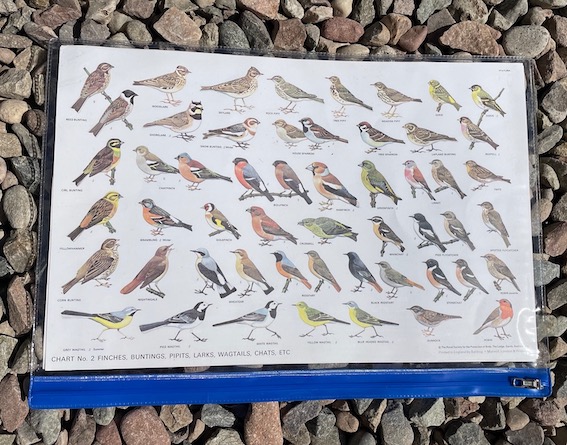
11. Photo display holders
For several years when I started working outside on a regular basis, I would use photo holders to store information and items. They are quick to move about and great for packaway play situations.The openings are on the sides and not the top so they can hold things that may blow away in place. I often use these for storing pieces of card that children can access for for mark making. However water can enter.
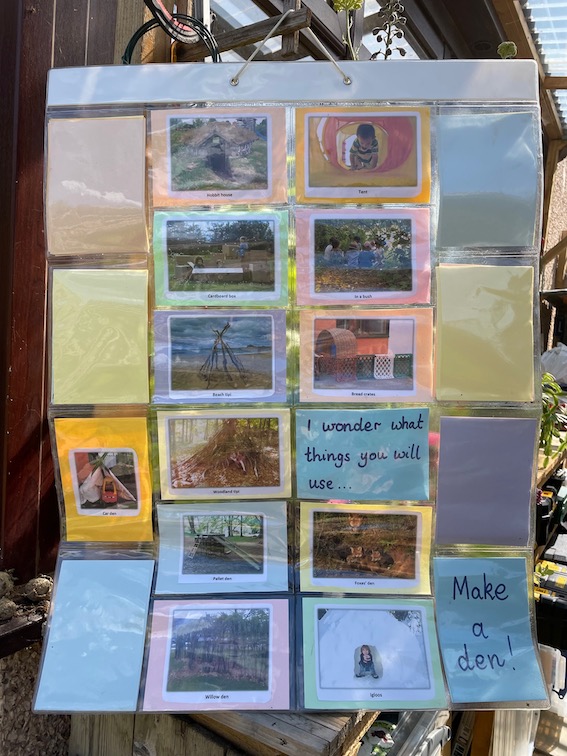
12. Plastic pocket card holders
These are made from heavy duty plastic and have a seal at the top. The seal needs to be shut to make them more waterproof. The downside is that they are expensive and can be quite heavy if you are carrying a lot of them around.
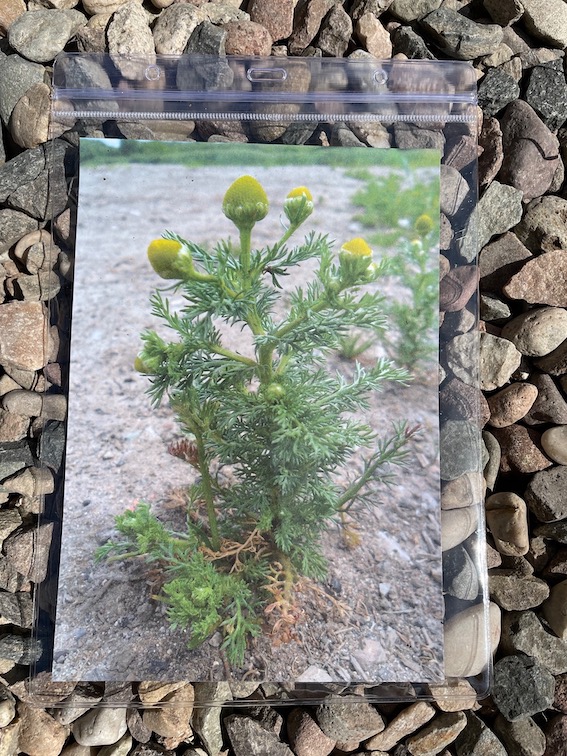
13. Polypockets
These are useful for holding instructions on wet days. Water can still leak in, but generally it’s a useful temporary measure especially if you insert the sheets from the bottom up. Go for higher quality ones which don’t split after a couple of uses. Another option is to use wipe clean pockets which are already commonplace in many schools. The are less fiddly to put sheets inside as there’s a bit more space and are heavier so less likely to blow about. They can also be used as wipe boards with marker pens:
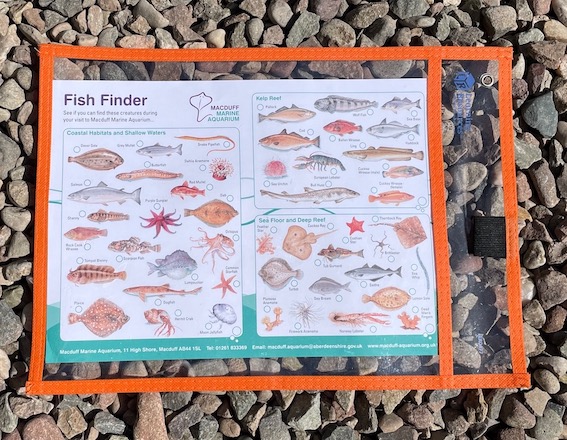
14. 35mm slide holders
This are surprisingly useful and robust. They work well for DIY flip charts, mini ID and micro scavenger hunts. They are always part of my pocket maths kit.
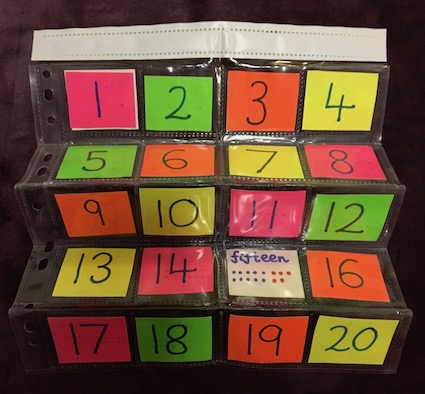
15. Waterproof clipboards
These are expensive but for some types of fieldwork they are really helpful. The link sends you to the VIP Weatherproof Writer website which also has weatherproof paper made from polyethylene fibres. This is something to be aware of – most waterproof paper seems to be made from a plastic of one sort or another. I’ve always made do with a plastic bag over an ordinary clipboard.
16. Magic whiteboard sheets
I use these a lot as they are foldable. The writing can also be removed with a damp cloth, if done promptly at the end of a session. The older these sheets get, the crustier they become and so seem to work even better outside. My aim is not to replace these once they are worn out – bear in mind that I bought most of my stock in 2010 so they are lasting well. Interestingly the same company are now selling “tree free” notebooks which are made from calcium carbonate rather than paper.

A good example of an alternative to the use of magic whiteboards came from this Dundee teacher, Callum, who used recycling sacks:

17. Displaying children’s work
A lot of the re-usable plastic options listed about work well for displaying children’s work. Below is a lovely example of an outdoor display board from Hill of Banchory Nursery that offers some protection from the elements – the photos are attached using velcro.
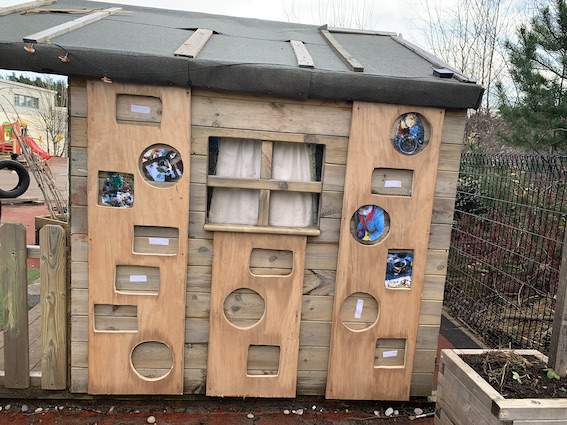
A more expensive and less environmentally friendly option is to invest in weatherproof noticeboards. The Stramash outdoor nurseries have these for parent information. If they are placed at child height then this could be useful for displaying children’s work or enabling them to create their own noticeboard.
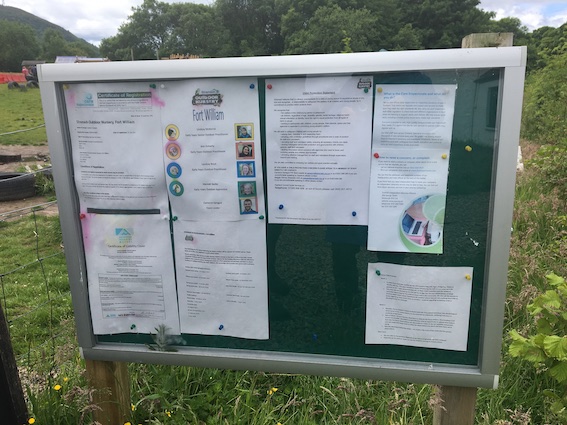
Finally, It is worth remembering that if your school has lots of laminate sheets, it’s better to use this up judiciously – bearing in mind, laminated paper lasts longer if used inside – rather than chuck them out. Or at least donate the unwanted materials to another school or organisation.
I know this is the type of blog post that I’ll end up amending fairly often as I find more alternatives and my own thinking evolves. Hopefully the ideas for re-usable plastics alternatives will no longer be needed. Please do comment and share your own experiences of experimenting with alternatives to laminates. It’s a learning process for most of us in education and together we can be much more environmentally aware and sustainable in our work.






























Some great ideas and suggestions there. I’ve never taken to lamination mostly due to my abilities to break machines and lack of patience with them.
I found printing directly on to card often helps resources last longer if they are to be reused multiple times and if you keep the image/information away from the edge it doesn’t matter if it gets a bit soft around the edges.
I like poly pockets outside as I can use treasury tags to hook them on to fences or bushes and reuse them with different information sheets in them for the children to find.